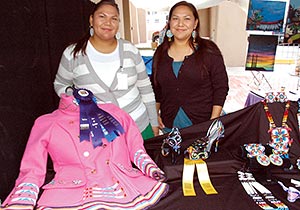2011 Santa Fe Indian Market
Young artists put spin on tradition
By Ernie Bulow
Special to the Times
SANTA FE, N.M., Aug. 25, 2011


(Special to the Times - Michelle Peina)
TOP: Venus Atcitty holding her inlaid concho belt at the 2011 Santa Fe Indian Market.
BOTTOM: J'shen and Jacinta Tsosie with their award-winning works at the 2011 Santa Fe Indian Market.
The Wheelwright, once known as the Museum of Navajo Ceremonial Art, has continued to expand its fellowship program, offering cash incentives to artists in the early stages of their careers.
This year there were 19 honorees, 10 of them Diné, and if the just-completed Santa Fe Indian Market is any guide, they are already making an impact.
Almost all the recipients were children or grandchildren of famous artists. Multitalented Ehren Natay, painter, sculptor, jeweler and musician, is the grandson of Gallup legend Ed Lee Natay, the first Native American to record a popular album as a singer and have his own radio show.
As a jeweler, Ehren works in a variety of metals, often combining silver, bronze and copper in a single piece, using pre-Columbian motifs. He is also a painter and a practicing musician, following in the footsteps of his grandfather.
Ben Patrick Haley of Twin Lakes, N.M., started silversmithing at the age of 7, helping his mother make silver beads and his father with tufa casting.
After high school he met Natasha Peshlakai, also a silversmith. Her father, Norbert Peshlakai, expanded his knowledge of the metalsmithing arts.
One of the most accomplished of this year's fellows is Venus Etcitty, a 22-year-old about to finish college and do graduate work in counseling. She had been silversmithing since the age of 13 and has already won prestigious awards at the Heard Museum and Indian Market.
Her parents, Ernest and Veronica Benally, are both smiths.
Sage Nunez-Navajo, Mexican/Japanese, is an eighth grader at Tuba City. Her grandfather Fidel Bahe has been teaching her all he knows about the skills of tufa casting, stamp work and other traditional techniques. She plays several musical instruments and plans on attending art school.
Lorenzo Shirley, another third-generation jeweler, was born in Fort Defiance but moved to Tucson. Aged 14, he picked up stone cutting by following his grandfather. After years apart, he re-connected with his chei and learned traditional silversmithing.
Though Shirley now works in a contemporary style, he learned to carve tufa blocks, draw his own wire, fabricate sheet silver, and do lapidary work. When he went back to school he expanded into other branches of the art, including stone faceting and lost-wax casting. He's becoming a multiple threat.
New mediums
Julie Marie Jamon has some experience under her belt. With her Zuni husband she owned and ran a store in Zuni Pueblo for 15 years, as well as several years in Gallup. Though exposed to Zuni jewelry work, she's on her own now, living in Fruitland, N.M. She recently discovered a new medium, silver clay.
The material is metal - silver or gold - in a clay suspension that allows it to be easily molded and manipulated. Once the piece is created, it is fired like pottery and the clay burns away, leaving a solid metal piece.
Jamon has come a long way since her mother supported nine family members on her income as a weaver. Julie learned the Two Grey Hills style of weaving from her mother so she has a traditional Navajo art background.
The youngest fellowship winner ever, Nicklaus Stanaland, is only 11 years old. Stanaland's work is as unusual as his tender age. He begins with a lozenge of clay that he paints and then fires. The clay disc is then glazed and re-fired. When the miniature painting is finished, he sets the piece in silver.
Stanaland's uncle, Allen Aragon, has been working in a similar style for years and is a regular at the Gallup Inter-Tribal Indian Ceremonial. His tiny paintings are extremely detailed and the finished pieces are amazing. He makes other jewelry and miniature pottery.
Sean Benally grew up in Farmington, the son of a mother who creates beaded jewelry, which inspired him, and brother to sculptor Ryan Benally.
Sean Benally has studied with several fine teachers and attended the Poeh Cultural Center in Pojoaque Pueblo. He leaves his cast pieces white from the pickle, rather than shining them to a metallic polish. He truly creates in "white metal."
Making their mark
Not surprisingly, recent Wheelwright Fellowship recipients have moved up in the prize category.
Chris Pruett took blue (first) and best in class in jewelry with a minimalist buckle at the Santa Fe Indian Market, while brother Pat Pruett got a special award for "innovative work" with a concho belt inlaid with computer chips.
Jay Jacob Livingston won a fistful of blue ribbons: first in traditional jewelry, first in concho belts and first in bolos. Livingston, from Sanders, Ariz., had been working silver since age 8.
Lynda Teller-Pete, a member of one of the "master" weaving families from Two Grey Hills, took best in class for a weaving that defies categorization.

